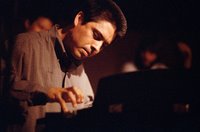 I had my first private lesson with pianist Randy Porter today. It's been years since I had a formal lesson with anybody. Randy has one of the deepest harmonic and rhythmic concepts I've ever encountered, plus he is my favorite saxophonist's (Charles McPherson) favorite pianist. We looked at a couple of standards and he gave me some new ideas to think about. One interesting harmonic device he showed me was a classic Bop delayed resolution for a Major chord. When you have a Major chord all you do is play a diminished chord/scale from the root of the Major chord and then resolve to the Major chord.
I had my first private lesson with pianist Randy Porter today. It's been years since I had a formal lesson with anybody. Randy has one of the deepest harmonic and rhythmic concepts I've ever encountered, plus he is my favorite saxophonist's (Charles McPherson) favorite pianist. We looked at a couple of standards and he gave me some new ideas to think about. One interesting harmonic device he showed me was a classic Bop delayed resolution for a Major chord. When you have a Major chord all you do is play a diminished chord/scale from the root of the Major chord and then resolve to the Major chord.So in the context of a ii-7 V7 Imaj7 it looks like this:
D-7 / G7 / Cdim Cmaj7/
Simple, just really nice classic Be-Bop.
Another thing he talked about was using a melodic minor up a fourth over a Major chord, then resolving to a Major 6 chord.
So over two bars of Gmaj7:
C-maj7 / G6 /
This is something McPherson likes to do and it sounds cool. It kind of suggests a G maj bebop scale by bringing out the #5 of the Major. I Guess you could look at this as a special function dominant b7 with a #11. You should really try to bring out the melodic minor sound with this one and then resolve to the 6th of the Major.
The most modern thing we worked on was four tonic substitutions over a Minor chord.
Randy had me play over Solar and over the first two bars of Cmin we substituted four different dominant 7th #9 chords, resolving after each one to the Cmelodic min. This is kind of a variation of Barry Harris' diminished subs where you can substitute any dominant seventh chord Minor thirds away from any other Dominant.
Example: over a C7 you can play a Eb7, Gb7, or A7 .
What we did was this-
over:
C-7 /C-7 /C-7 / C-7 /
We played this:
D7alt Cmel- / F7alt Cmel- / Ab7alt Cmel- / B7alt Cmel- /
or you can think of it like this:
Ebmel- Cmel-/ F#mel- Cmel-/ Amel- Cmel- / Cmelodic- /
Randy seems to be a
 ble to play anything over anything and still sound great. These harmonic devices seemed to be true classical BeBop (except the last one). My buddy Tom said that McPherson had shown him some of the same things when he took a lesson with him. I would highly encourage anyone to study with either of these modern Jazz masters. Charles McPherson lives in San Diego and is always available for private students and Randy Porter is in Portland, Oregon. If you're lucky you may just be able to hear them play together, otherwise check out their recordings.
ble to play anything over anything and still sound great. These harmonic devices seemed to be true classical BeBop (except the last one). My buddy Tom said that McPherson had shown him some of the same things when he took a lesson with him. I would highly encourage anyone to study with either of these modern Jazz masters. Charles McPherson lives in San Diego and is always available for private students and Randy Porter is in Portland, Oregon. If you're lucky you may just be able to hear them play together, otherwise check out their recordings.Randy Porter's recordings
Randy Porter's workshops
Contact Randy Porter at: randyporter@randyporter.com
Charles McPherson's recordings (also try iTunes)
Contact Charles McPherson at: jazz@charlesmcpherson.com

















